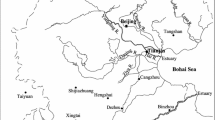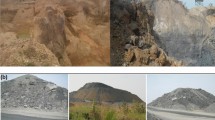Abstract
This paper reports the site investigations (geological, geophysical and geotechnical) for the construction of a block of five buildings, with nine storeys each, in the Muratpasa District, Antalya. The base rocks consist of travertines that have been affected by domestic and industrial liquid wastes that were injected directly into the travertine plateau through septic holes prior to 2000. Therefore, the travertine rocks have poor engineering properties, such as high deformability and insufficient strength. This causes problems in the construction of engineered structures, and detailed investigations were required to determine the potential risk to the foundations of the buildings, and what measures would be required to mitigate those risks. In this study, the effects of injected wastewaters on the mass and material properties of travertine rocks, as well as overall reinforcement of the foundation, were investigated. Further investigations for foundations were recommended and implemented.
Résumé
Cet article présente les enquêtes sur le terrain (géologiques, géophysiques et géotechniques) pour la construction d’un bloc de cinq bâtiments, avec neuf étages chacun, dans le district de Muratpasa, Antalya. Les roches de base se composent de travertins qui ont été touchées par les déchets liquides domestiques et industriels qui ont été injectés directement dans le plateau de travertin à travers les trous septiques avant 2000, donc, les rochers de travertin ont des propriétés d’ingénierie pauvres, comme la haute déformabilité et résistance insuffisante. Cela provoque des problèmes dans la construction des ouvrages d’art et des analyses détaillées ont été nécessaires pour déterminer le risque potentiel pour les fondations des bâtiments, et les mesures qui seraient nécessaires pour atténuer ces risques. Dans cette étude, les effets d’eaux usées injectées sur les propriétés de masse et matériels de roches de travertin, ainsi que le renforcement global de la fondation, ont été étudiés. D’autres investigations pour les fondations ont été recommandées et mises en œuvre.






Similar content being viewed by others
References
Abdeltawab S (2013) Karst limestone foundation geotechnical problems, detection and treatment: case studies from Egypt and Saudi Arabia. Int J Sci Eng Res 4(5):376–387
Abu-Shariah MII (2009) Determination of cave geometry by using a geoelectrical resistivity inverse model. Eng Geol 105:239–244
Al-fares W, Bakalowicz M, Guérin R, Duckam M (2002) Analysis of the karst aquifer by means of a ground penetrating radar (GPR): example of the Lamalou area (Hérault, France). J Appl Geophys 51:97–106
Arosemena RL (2007) Effect of horizontal piles on the soil bearing capacity for circular footing above cavity. B.S. Peruvian University of Applied Sciences, Department of Civil and Environmental Engineering, MSc thesis, Orlando
Asta MP, Gimeno MJ, Auqué LF, Gómez J, Acero P, Lapuente P (2010) Secondary processes determining the pH of alkaline waters in crystalline rock systems. Chem Geol 276:41–52
Ballouz M (2005) Micropiling in karstic rock: new CMFF foundation solution applied at the Sanita Factory, technical paper, ASCE Special Publication. In: Tenth multidisciplinary conference on sinkholes and the engineering and environmental impact of karst TM, San Antonio
Basal A, Ekmekci M (2000) Natural attenuation characteristics of the Antalya Travertine Plateau soil zone as protective cover for the aquifer. Earthsciences 22:79–95
Beres M, Luetscher M, Olivier R (2001) Integration of ground penetrating radar and microgravimetric methods to map shallow caves. J Appl Geophys 46:249–262
Bishop I, Styles P, Emsley SJ, Ferguson NS (1997) The detection of cavities using the microgravity technique: case histories from mining and karstic environments. Geol Soc Lond Eng Geol Spec Publ 12:153–166
Brinker FA, Kazaniwsky PW, Logan M (2004) Case history illustrating the challenges of foundation design and construction in karst terrain. In: Proceedings of the fifth international conference on case histories in geotechnical engineering, New York, 13–17 April 2004
Burger A (1990) The travertine complex of Antalya, Southwest Turkey. Z Geomorphol Suppl Bd 77:25–46
Carrière SD, Chalikakis K, Sénéchal G, Danquigny C, Emblanch C (2013) Combining electrical resistivity tomography and ground penetrating radar to study geological structuring of karst unsaturated zone. J Appl Geophys 94:31–41
Chalikakis K, Plagnes V, Guerin R, Vallois R, Bosch FP (2011) Contribution of geophysical method for karst-system exploration: an overview. Hydrogeol J 19:1169–1180
Cook JC (1965) Seismic mapping of underground cavities using reflection amplitudes. Geophysics 30(4):527–538
Cushing AG, Stonecheck SA, Campbell BD, Dodds SD (2004) An evaluation of the load-displacement behavior and load test interpretation of micropiles in rock. In: Proceedings of fifth international conference on case histories in geotechnical engineering, New York, 13–17 April 2004
Deceuster J, Delgranche J, Kaufmann O (2006) 2D cross-borehole resistivity tomographies below foundations as a tool to design proper remedial actions in covered karst. J App Geophys 60:68–86
Dotson D, Tarquinio F (2003) A creative solution to problems with foundation construction in karst. In: Ninth multidisciplinary conference on sinkholes and the engineering and environmental impacts of karst, Huntsville
General Directorate of State Hydraulic Works (1985) Antalya-Kirkgoz kaynakları ve traverten platosu karst hidrojeolojik etud raporu. Jeoteknik Hizmetler ve Yeraltısuyu Dairesi Baskanlıgı, Ankara, 131 pp. (in Turkish)
El-Qady G, Hafez M, Abdalla MA, Ushijima K (2005) Imaging subsurface cavities using geoelectric tomography and ground-penetrating radar. J Cave Karst Stud 67:174–181
Epting J, Huggenberger P, Glur L (2009) Integrated investigations of karst phenomena in urban environments. Eng Geol 109:273–289
Fischer JA, Fischer JJ (1997) Wyndham farms—a karst case study. In: Beck BF and Stephensen JB (eds) The engineering geology and hydrogeology of karst terranes. Proceedings of the 6th multidisciplinary conference on sinkholes and the engineering and environmental impacts of karst, Springfield, Missouri, 6-9 April, Brookfield (VT): A.A. Balkema, Rotterdam, pp 287-292
Gibson PJ, Lyle P, George DM (2004) Application of resistivity and magnetometry geophysical techniques for near-surface investigations in karstic terranes in Ireland. J Cave Karst Stud 66(2):35–38
Glover C, Robertson AF (2003) Origin of tufa (cool-water carbonate) and related terraces in the Antalya area, SW Turkey. Geol J 38:329–358
Guérin R, Baltassat JM, Boucher M, Chalikakis K, Galibert PY, Girard JF, Plagnes V, Valois R (2009) Geophysical characterisation of karstic networks—application to the Ouysse system (Poumeyssen, France). C R Geosci 341:810–817
ISRM (International Society for Rock Mechanics) (1981) Rock characterization, testing and monitoring. In: Brown ET (ed) ISRM suggested methods. Pergamon, Oxford
Johnson RB, De Graff VJ (1988) Principles of engineering geology. Willey, New York
Karabıyıkoglu M, Tuzcu S, Ciner A, Deynoux M, Orcen S, Hakyemez A (2005) Facies and environmental setting of the Miocene coral reefs in the late-orogenic fill of the Antalya Basin, western Taurides, Turkey: implications for tectonic control and sea-level changes. Sediment Geol 173:345–371
Karaman A, Karadaylar T (2004) Identication of karst features using seismic p-wave tomography and resistivity anisotropy measurements. Environ Geol 45:957–962
Kaufmann O, Deceuster J (2005) Ground investigation in covered karst near Tournai, Belgium. Case study. In: Waltham T, Bell F, Culshaw M (eds) Sinkholes and subsidence-karst and cavernous rocks in engineering and construction. Praxis, Chichester, pp 347–350
Kaufmann O, Quinif Y (2001) An application of cone penetration tests and combined array 2D electrical resistivity tomography to delineate cover-collapse sinkholes prone areas. In: Beck BF, Herring JG (eds) Geotechnical and environmental applications of karst geology and hydrology. Balkema, pp 359–364
Kaufmann O, Quinif Y (2002) Geohazard map of cover-collapse sinkholes in the Tournaisis area, southern Belgium. Eng Geol 65:117–124
Kaufmann O, Deceuster J, Quinif Y (2012) An electrical resistivity imaging-based strategy to enable site-scale planning over covered palaeokarst features in the Tournaisis area (Belgium). Eng Geol 133–134:49–65
Kilic R, Yavuz S (1994) Relationship between geotechnical properties of the Antalya travertine (Turkey). Bull Int Assoc Eng Geol 50:43–50
Klimchouck A (1997) The nature and principal characteristics of epikarst. In: Proceedings of the 12th international congress speleology, La Chauds-de-Fonds, Aug 1997
Mishu LP, Godfrey JD, Mishu JR (1997) Foundation remedies for residential construction over karst limestone in Nashville, Tennessee. In: Beck BF, Stephensen JB (eds) Karst Geohazards: Engineering and Environmental Problems in Karst Terrane. Proceedings of the sixth multidisciplinary conference on sinkholes and the engineering and environmental impacts of karst, Springfield, Missouri, 6-9 April, Brookfield (VT): A.A. Balkema, Rotterdam, pp 319–323
Mochales T, Casas AM, Pueyo EL, Pueyo Ó, Román MT, Pocoví A, Soriano MA, Ansón D (2008) Detection of underground cavities by combining gravity, magnetic and ground penetrating radar: a case study from the Zaragoza area, NE Spain. Environ Geol 53(5):1067–1077
Nativ R, Gunay G, Hotzl H, Reichert B, Solomon DK, Tezcan T (1999) Separation of groundwater-flow components in a karstified aquifer using environmental tracers. Appl Geochem 14:1001–1014
Pueyo-Anchuela O, Casas-Sainz AM, Soriano MA, Pocoví-Juan A (2010) A geophysical survey routine for the detection of doline areas in the surroundings of Zaragoza (NE Spain). Eng Geol 114:382–396
Quinta Ferreira M, Velho JL (2006) Construction problems on the karstified limestone tuffs of Condeixa, central Portugal: a case study. Geotech Geol Eng 24:101–116
Roth MJS, Mackey JR, Mackey C, Nyquist JE (2002) A case study of the reliability of multielectrode earth resistivity testing for geotechnical investigations in karst terrains. Eng Geol 65:225–232
Rybakov M, Rotstein Y, Shirman B, Al-Zoubi A (2005) Cave detection near the Dead Sea—a micromagnetic feasibility study. Lead Edge (Soc Explor Geophys) 24(6):585–590
Siegel TC, Caskey JM, Huckaba DA (2005) Combination of ground improvement techniques for support of shallow foundations in karst. Geotechnical Special Publications 130–142 and GRI-18. In: Proceedings of the geo-frontiers 2005 congress, Austin, 24–26 Jan 2005
Singh TN, Singh SK, Mishra A, Singh PK, Singh VK (1999) Effect of a acidic water on physico-mechanical behaviour of rock. Indian J Eng Mater Sci 6:66–72
Stille H, Gustafson G, Hassler L (2012) Application of new theories and technology for grouting of dams and foundations on rock. Geotech Geol Eng 30:603–624
Sumanovac F, Weisser M (2001) Evaluation of resistivity and seismic methods for hydrogeological mapping in karst terrains. J Appl Geophys 47:13–28
Tan YC, Chow CM (2006) Foundation design and construction practice in limestone area in Malaysia. HKIE-IEM Seminar on Geotechnical Works in Marble, Hong Kong
Thierry P, Debeblia N, Bitri A (2005) Geophysical and geological characterisation of karst hazards in urban environments: application to Orleans (France). Bull Eng Geol Environ 64:139–150
Traylor RP, Cadden AW, Bruce DA (2002) High capacity micropiles in karst: challenges and opportunities. In: Proceedings of the international deep foundations congress, Orlando, pp 743–759, 14–16 Feb 2002
TSE (1987) Methods of testing rocks. Turkish Standards Institute-699, Ankara, Turkey
Turker AE, Keceli DA, Kamacı Z, Kaya MA (1991) The ground problems of urban area in Antalya and their resolutions by means of geophysical methods. Jeofizik 5:27–42 (in Turkish with English abstract)
Uranowski DD, Dodds SD, Stonecheck SA (2004) Micropiles in karstic dolomite: similarities and differences of two case histories. In: Proceedings of sessions of the geosupport conference: innovation and cooperation in the geo-industry, Orlando, 29–31 Jan 2004
Van Schoor M (2002) Detection of sinkholes using 2D electrical resistivity imaging. J Appl Geophys 50:393–399
Waltham T, Bell F, Culshaw M (2005) Sinkholes and subsidence-karst and cavernous rocks in engineering and construction. Praxis, Chichester 382 pp
White WB (1988) Geomorphology and hydrology of karst terrains. Oxford University Press, Oxford 464 pp
Zhou W, Beck BF, Adams AL (2002) Effective electrode array in mapping karst hazards in electrical resistivity tomography. Environ Geol 42:922–928
Acknowledgments
The author would like to thank the building owner and design consultants who provided the necessary data for this study. Special thanks are due to Dr. Konstantinos Chalikakis and Dr. John Deceuster for their comments, which helped improve the content and quality of this paper.
Author information
Authors and Affiliations
Corresponding author
Rights and permissions
About this article
Cite this article
Ozcelik, M. Effect of wastewater on building foundation in karst travertine areas in Antalya, Turkey. Bull Eng Geol Environ 74, 1213–1224 (2015). https://doi.org/10.1007/s10064-014-0695-4
Received:
Accepted:
Published:
Issue Date:
DOI: https://doi.org/10.1007/s10064-014-0695-4




